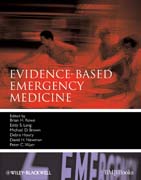
Emergency physicians assess and manage a wide variety of problems from patients presenting with a diversity of severities, ranging from mild to severe and life-threatening. They are expected to maintain their competency and expertisein areas where there is rapid knowledge change. Evidence-based Emergency Medicine is the first book of its kind in emergency medicine to tackle the problems practicing physicians encounter in the emergency setting using an evidence-based approach. It summarizes the published evidence available for the diagnosis and treatment of common emergency health care problems in adults. Each chapter contextualizes a topic area using a clinical vignette and generates a series of key clinically important diagnostic and treatment questions. By completing detailed reviews of diagnostic and treatment research, using evidence from systematic reviews, RCTs, and prospective observational studies, the authors provide conclusions and practical recommendations. Focusing primarily on diagnosis in areas where evidence for treatment is well accepted (e.g. DVTs), and treatment in other diseases where diagnosis is not complex (e.g. asthma), this text is written by leading emergency physicians at the forefront of evidence-based medicine. Evidence-based Emergency Medicine is ideal for emergency physicians and trainees, emergency department staff, and family physicians specialising in the acute care of medical and injured patients. INDICE: List of Contributors. Foreword. Acknowledgments. List of Abbreviations. Part 1 General Issues. 1 Introduction. 2 Knowledge Translation: a Primerfor Emergency Physicians. 3 Critical Appraisal: General Issues in Emergency Medicine. 4 Continuing Education. 5 Quality Improvement. 6 Medication Adherence. 7 Emergency Department Triage. 8 Emergency Department Overcrowding. Part 2 Respiratory. 9 Emergency Management of Asthma Exacerbations. 10 Chronic Obstructive Pulmonary Disease Exacerbations. 11 Diagnosis and Treatment of Community-Acquired Pneumonia. 12 Deep Vein Thrombosis. 13 Pulmonary Embolism. 14 Prevention and Treatment of Influenza. 15 Anaphylaxis. Part 3 Cardiology. 16 Chest Pain. 17 Acute Coronary Syndromes. 18 Acute Myocardial Infarction. 19 Acute Decompensated Heart Failure. 20 Acute Fibrillation. 21 Ventricular and Supraventricular Arrhythmias. 22 Cardiac Arrest. Part 4 General Medical Conditions. 23 Severe Sepsis and Septic Shock. 24 Delirium. 25 Caring for the Elderly. 26 Syncope. 27 General Toxicology. 28 Toxicology: Acetaminophen and Salicylate Poisoning. Part 5 Injury. 29 Minor Traumatic Brain Injury. 30 Neck Injuries. 31 AnkleInjuries. 32 Knee Injuries. 33 Wrist injuries. 34 Shoulder Injuries. 35 ChestTrauma. 36 Hemorrhagic Shock. Part 6 Genitourinary and Abdominal. 37 Acute Appendicitis. 38 Ectopic Pregnancy. 39 Acute Ureteric Colic. 40 Urinary Tract Infection. 41 Pelvic Inflammatory Disease. 42 Pregnancy. 43 Gastrointestinal Bleeding. Part 7 Neurosciences. 44 Transient Ischemic Attack. 45 Stroke. 46 Subarachnoid Hemorrhage. 47 Bacterial Meningitis. 48 Migraine and Other Primary Headache Disorders. 49 Seizures. 50 The Agitated Patient. Part 8 ENT. 51 Sore Throat. 52 Sinusitis. 53 Conjunctivitis. Part 9 Minor Procedures. 54 Procedural Sedation and Analgesia. 55 Wound Repair. 56 Soft Tissue Abscess. 57 Ultrasound Use: Three Select Applications. Part 10 Public Health. 58 Injury Prevention. 59 Intimate Partner Violence. 60 Smoking Cessation. 61 Immunization. 62 Alcoholand Other Drugs. 63 Elder Abuse. Index
- ISBN: 978-1-4051-6143-5
- Editorial: Blackwell
- Encuadernacion: Cartoné
- Páginas: 680
- Fecha Publicación: 31/10/2008
- Nº Volúmenes: 1
- Idioma: Inglés
